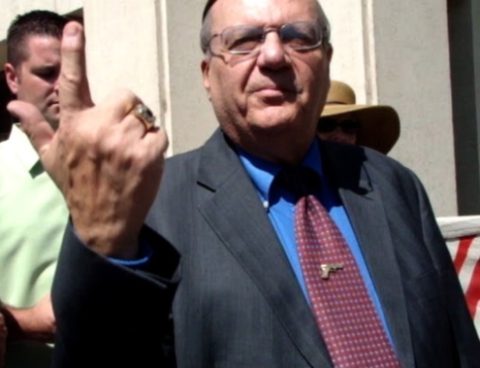Reform

Is Secure Communities Making our Communities Secure?
The Secure Communities Program—the latest partnership between Immigration and Customs Enforcement (ICE) and local jails to identify and deport “criminal aliens” —is over a year old and is growing by leaps and bounds. To date, there has been very little public information available about what Secure Communities is, how it works, and what the results have been. However, a new IPC report, The Secure Communities Program: Unanswered Questions and Continuing Concerns, released today highlights early evidence from Secure Communities—and experience with other ICE programs—that suggests this new program may not be living up to its name and may not be effectively making our communities more safe. Read More

Our Immigration System Needs Solutions, Not Villains
This week, American Apparel is slated to lay off 1,800 workers from its clothing factory in Los Angeles. The impending layoffs are the result of a federal investigation which turned up irregularities in the documents workers presented when first hired by the company. The investigation itself represents a new direction in Department of Homeland Security (DHS) immigration enforcement, one which focuses on audits of employment records rather than mass roundups and S.W.A.T.-team raids—raids which inflicted abuse and trauma on immigrants, their families and our communities. Read More

CIS’s ID Theft Argument Makes Strong Case for Comprehensive Immigration Reform
Once again, opponents of immigration reform have actually made a strong case for comprehensive immigration reform. At an event this morning sponsored by the Center for Immigration Studies (CIS), various speakers argued that ID theft by unauthorized immigrants is a problem that needs to be solved. While they seemed unwilling to offer any real solutions, the issues raised in the discussion clearly point toward the need for comprehensive immigration reform—including a legalization program for current undocumented immigrants—which would be a large and important step toward curbing the use of fraudulent documents by unauthorized immigrants. Read More

New Report Measures Widening Gap Between Republicans and Latino Voters
A New York Times article from 1882 stated, “It is a trite saying that in a free country public opinion rules. […] It often happens that a question of policy becomes of pressing importance before public opinion develops in regard to it.” More than one-hundred years later, this idea remains true—especially in regard to Latino voters and the Republican Party. Read More

Faith and Leadership Required: A Closer Look at Last Week’s White House Meeting
Last week’s White House meeting on immigration marked another chapter in the years-long effort to enact comprehensive immigration reform. Janet Napolitano’s invitation to more than one hundred representatives from business, labor, faith, law enforcement, and immigration groups was a genuine attempt to listen to concerns and solicit ideas. The format—large group meeting addressed by the Secretary, small group discussion led by various DHS and White House officials, summary and surprise remarks from the President—gave people a chance to say just a little, but the cumulative effect was more important than we may realize. Read More

States and Localities Critical to Immigration Policies
Governors and mayors, state legislatures and city councils are playing an increasingly critical role in U.S. immigration policy. As a result of Congress’s inaction, states and localities are feeling pressure to take action on immigration, and many of the policies that directly impact immigrants’ lives—law enforcement, public benefits, driver’s licenses—are being driven by new state and local laws. Some state and local immigration policies have been positive and have helped to integrate immigrants into American communities. Others, however, have had a harmful impact on immigrants as well as on public health and safety. The National Conference of State Legislatures (NCSL), a bipartisan organization that serves the legislators and staffs of the nation's 50 states, recently published two documents that highlight the role that states play in immigration policy. One is a report on recent state activity, and the other is NCSL’s official immigration policy statement. Read More

Kicking Down Doors, Stomping on Rights: New Report Reveals Disturbing Details of ICE Raids
Last week the Immigration Justice Clinic of the Benjamin N. Cardozo School of Law at Yeshiva University in New York published a disturbing study that documents ICE’s home raid operations. Constitution on ICE: A Report on Immigration Home Raid Operations found that over the last several years, ICE has increasingly conducted home raids, meaning that they gone to private homes to arrest people rather than doing it in public settings. The report finds a pattern of constitutional violations occurring during home raids including agents kicking in doors and forcing their way into private residences during pre-dawn hours without warrants or other legal authority. ICE agents also seize non-target residents, or “collaterals” from their homes, even if there is no legal authority to take that individual into custody. According to the report, these arrests are based on racial or ethnic profiling. Finally, the authors also found that ICE was illegally searching homes. The stories speak for themselves... Read More

New Yorker Profile of Joe Arpaio is Not a Pretty Picture
The July 20th issue of The New Yorker paints a detailed portrait of Maricopa County, Arizona’s Sheriff Joe Arpaio—and it is not a pretty picture. The profile of “Sheriff Joe” that emerges from the story by journalist William Finnegan is that of a man obsessed with publicity and self-promotion, who has a deep streak of sadism and little regard for the U.S. Constitution, civil rights, actual crime-fighting, or protecting the safety of the public he ostensibly serves. While Arpaio persists in his personal crusade against unauthorized immigrants, serious crimes go unsolved, emergency-response times climb, and the rights of native-born Americans and immigrants alike are routinely trampled in the process. The most remarkable aspect of this story is that Arpaio is still legally permitted to carry a badge and a gun after more than a decade and a half of egregiously abusing his power. Read More

New Yorker Profile of Joe Arpaio is Not a Pretty Picture
Photo by TheRagBlog. The July 20th issue of The New Yorker paints a detailed portrait of Maricopa County, Arizona’s Sheriff Joe Arpaio—and it is not a pretty picture. The profile of “Sheriff Joe” that emerges from the story by journalist William Finnegan is that of a man obsessed with publicity and self-promotion, who has a deep streak of sadism and little regard for the U.S. Constitution, civil rights, actual crime-fighting, or protecting the safety of the public he ostensibly serves. While Arpaio persists in his personal crusade against unauthorized immigrants, serious crimes go unsolved, emergency-response times climb, and the rights of native-born Americans and immigrants alike are routinely trampled in the process. The most remarkable aspect of this story is that Arpaio is still legally permitted to carry a badge and a gun after more than a decade and a half of egregiously abusing his power. Read More
Make a contribution
Make a direct impact on the lives of immigrants.

